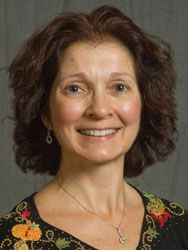Publication
Article
Oncology Nursing News
Yoga Benefits Patients With Breast Cancer
Author(s):
Patients with breast cancer who undertook yoga following radiotherapy derived physical and emotional benefi ts from the ancient Indian practice, according to research presented at ASCO.

Patients with breast cancer who undertook yoga following radiotherapy derived physical and emotional benefits from the ancient Indian practice, according to research presented at ASCO.
The study randomized 163 stage 0-III breast cancer patients to either yoga (n = 53), stretching (n = 56), or a wait-listed control group (n = 54). The yoga and stretching groups met 3 times a week for 6 weeks during radiotherapy.
Patients self-reported changes in fatigue, physical function, depression, benefit finding, and spirituality. The authors also assessed cortisol slope and heart rate variability (HRV) with saliva tests and 10-minute electrocardiograms that were collected at baseline, end of treatment, and 1, 3, and 6 months’ follow-up.
By the end of radiotherapy, the yoga and stretching groups showed marked improvements in various study endpoints compared with the control group. The results were calculated as change scores:
- Changes in fatigue: yoga (-0.23, for a reduction), stretching (-0.45, for a reduction), wait-list control (0.52, for an increase), P < .05 for all
- Increase in physical function: yoga (5.8 at 1 month, 6.5 at 3 months, 6.1 at 6 months), stretching (2.0, 3.4, 3.4), wait-list control (0.8, -0.2, 1.1); P < .05 for all
- Increase in benefit finding: yoga (3.1 at 3 months and 1.1 at 6 months), stretching (-2.5 and -3.9), wait-list control (-2.5 and -4.7); P < .05 for all
Nurses Perspective

Yoga Facilitates Healthy Living for Patients and Survivors
Lisa Marie Bernardo, PhD, MPH, RN, HFS
It is not surprising that yoga, as compared with stretching and usual practice (control group), improved outcomes such as decreasing fatigue, improving physical functioning, and improving cortisol levels in women with breast cancer undergoing radiation treatment. The results also demonstrated a positive, linear relationship between yoga attendance and beneficial outcomes. Additionally, no injuries or adverse events occurred.
More researchers are turning to yoga practice as a noninvasive method to help women with breast cancer during and after their treatment. Such research allows for the development of evidence-based protocols for conducting yoga sessions in this population.
Oncology nurses can investigate yoga classes for cancer patients and survivors that are offered in their community and recommend reputable instructors to their patients. While 3 times a week for yoga practice may seem prohibitive in terms of time and money, yoga is truly a practice for living a healthy life. Yoga transcends the physical poses, breathing practices, and respect for self in the classroom and becomes a daily practice. One’s choices for selecting food to eat, responding to a stressful situation, and taking care of oneself are practiced every day.
You can learn more about yoga for people with cancer in the Yoga for Cancer Care blog at Yoga for Cancer Care.
There were no differences in scores for spirituality and depression.
The authors also found that the cortisol slope at the end of radiotherapy was steepest for the yoga group compared with the stretching and wait-list control arms (-0.12, -0.08, -0.08, respectively; P <.01 for all).
Yoga has been credited with acting as a stress buffer during radiotherapy, and “what we see by the end of radiotherapy is a split, where the yoga group had the steepest cortisol slope. Blunting of the cortisol slope is actually a predictor of mortality in stage IV disease,” said Lorenzo Cohen, PhD, director of the Integrative Medicine Program in the General Oncology Department at the MD Anderson Cancer Center in Houston, Texas.
Finally, there were significant increases in HRV from baseline to post-therapy for the yoga group (64.3 ms; P < .05) but not for the stretching group (5.8 ms) or the wait-list control arm (-8.1 ms).
His group is now recruiting 600 patients for a phase III trial in which patients will be blinded to the opposite study arm (yoga vs another type of stress management). This will address criticism from the cancer community that yoga offers little more than a placebo effect, Cohen said. The followup for this study will be 1 year, and the authors also will assess economic outcomes, he added. Abstract 9009










